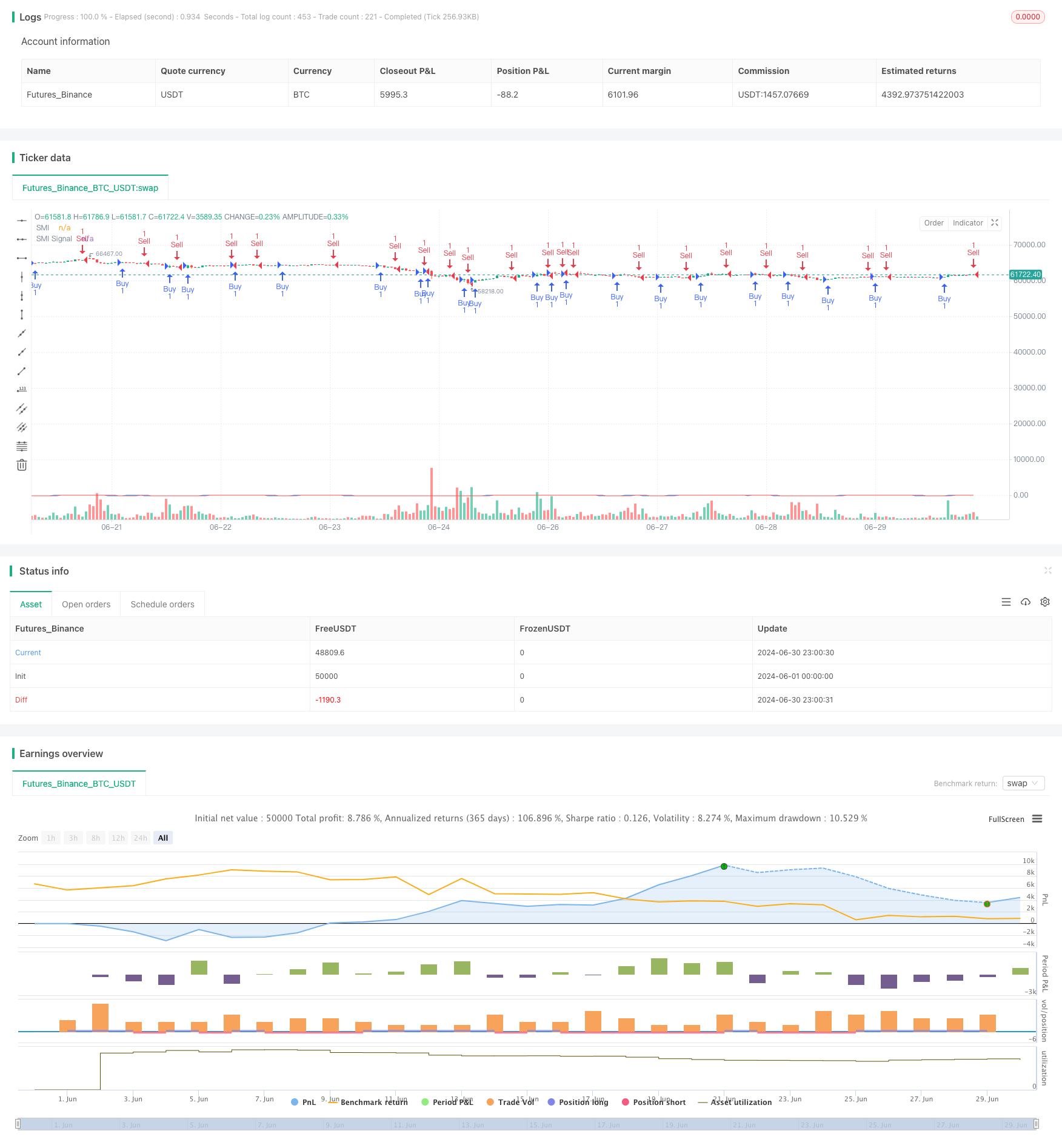
概述
本策略是一种结合随机动量指标(SMI)和标准枢轴点的交易系统。它主要利用SMI指标的交叉信号来判断市场动量的变化,同时结合价格在枢轴点附近的位置来确定入场时机。这种方法旨在捕捉市场的动量变化,同时利用重要的支撑和阻力水平来提高交易的准确性。
策略原理
该策略的核心是基于SMI指标的计算和信号生成。SMI是一种动量指标,通过计算收盘价相对于最高价和最低价的位置来衡量市场动量。具体步骤如下:
计算SMI组件:
- 在给定周期内找出最高价(h)和最低价(l)
- 计算中间值 m = (h + l) / 2
- 计算价格与中间值的差距百分比 d = (价格 - m) / (h - l) * 100
计算SMI值:
- 对d值进行K周期的简单移动平均,得到SMI
- 对SMI再进行D周期的简单移动平均,得到SMI信号线
生成交易信号:
- 当SMI线从下方穿过信号线时,产生买入信号
- 当SMI线从上方穿过信号线时,产生卖出信号
结合枢轴点:
- 只有当价格接近标准枢轴点水平时,才执行上述交易信号
这种方法结合了动量指标的趋势跟踪能力和枢轴点的支撑阻力概念,旨在提高交易的准确性和盈利能力。
策略优势
动量捕捉: SMI指标能有效捕捉市场动量的变化,有助于及时发现潜在的趋势反转或延续。
过滤假信号: 通过结合枢轴点,策略可以过滤掉一些可能的假信号,只在价格接近关键支撑阻力位时才进行交易。
灵活性: 策略参数可以根据不同的市场条件和交易品种进行调整,以适应不同的交易环境。
视觉化: 策略在图表上绘制了SMI和信号线,便于交易者直观地观察市场动量的变化。
自动化: 策略可以通过编程实现全自动化交易,减少人为情绪干扰。
策略风险
滞后性: 由于使用了移动平均线,SMI指标可能存在一定的滞后性,在快速变化的市场中可能错过一些交易机会。
假突破: 在横盘市场中,SMI可能产生频繁的交叉信号,导致错误的交易。
枢轴点定义: 策略依赖于标准枢轴点,但不同的枢轴点计算方法可能导致不同的结果。
参数敏感性: 策略的表现可能对SMI的长度和平滑参数敏感,需要仔细优化。
市场条件依赖: 在某些市场条件下,如高波动性或趋势不明显的情况,策略可能表现不佳。
为了降低这些风险,可以考虑以下措施: - 增加额外的过滤条件,如趋势过滤器或波动性指标 - 使用自适应参数来动态调整SMI的计算周期 - 结合其他技术指标或基本面分析来确认信号 - 实施严格的风险管理,如设置止损和利润目标
策略优化方向
动态参数调整: 可以根据市场波动性自动调整SMI的长度和平滑参数,以适应不同的市场环境。
多时间框架分析: 引入更长时间框架的SMI信号作为过滤器,以减少短期噪音的影响。
量化枢轴点影响: 可以根据价格与枢轴点的距离来调整仓位大小或设置不同的进场条件。
优化出场策略: 目前策略只关注入场,可以添加基于SMI指标的出场逻辑,如反向交叉或超买超卖水平。
引入波动性过滤: 在高波动性期间调整策略参数或暂停交易,以避免虚假信号。
整合趋势指标: 结合如移动平均线或ADX等趋势指标,只在主趋势方向上交易。
回测与优化: 对不同的参数组合进行全面的回测,找出最优的参数设置。
这些优化方向旨在提高策略的稳定性和适应性,同时减少假信号和提高盈利能力。
总结
SMI与枢轴点结合的动量交叉策略是一种结合技术分析和价格行为的交易方法。它利用SMI指标捕捉市场动量的变化,同时通过枢轴点来确定重要的价格水平。这种方法的优势在于能够有效地识别潜在的趋势变化,同时利用关键支撑阻力位来提高交易的准确性。
然而,该策略也面临着一些挑战,如信号滞后和假突破的风险。为了克服这些问题,交易者需要仔细优化参数,并考虑引入额外的过滤条件。通过持续的回测和优化,以及结合其他技术指标和分析方法,可以进一步提高策略的性能和稳定性。
总的来说,这是一个有潜力的交易策略框架,适合那些希望在技术分析基础上构建系统化交易方法的交易者。通过适当的风险管理和持续的策略改进,它有可能成为一个可靠的交易工具。
/*backtest
start: 2024-06-01 00:00:00
end: 2024-06-30 23:59:59
period: 1h
basePeriod: 15m
exchanges: [{"eid":"Futures_Binance","currency":"BTC_USDT"}]
*/
//@version=5
strategy("SMI Strategy", overlay=true)
// Parameters for SMI
smiLength = input.int(8, title="SMI Length")
smiK = input.int(6, title="SMI K Length")
smiD = input.int(6, title="SMI D Length")
smiSource = input.source(close, title="SMI Source")
// Calculate SMI components
h = ta.highest(smiSource, smiLength)
l = ta.lowest(smiSource, smiLength)
m = (h + l) / 2
d = (smiSource - m) / (h - l) * 100
// Calculate SMI
smi = ta.sma(d, smiK)
smiSignal = ta.sma(smi, smiD)
// Define conditions for buy and sell signals
bullishCondition = ta.crossover(smi, smiSignal)
bearishCondition = ta.crossunder(smi, smiSignal)
// Generate buy and sell signals
if (bullishCondition)
strategy.entry("Buy", strategy.long)
if (bearishCondition)
strategy.entry("Sell", strategy.short)
// Plot SMI and SMI Signal
plot(smi, title="SMI", color=color.blue)
plot(smiSignal, title="SMI Signal", color=color.red)